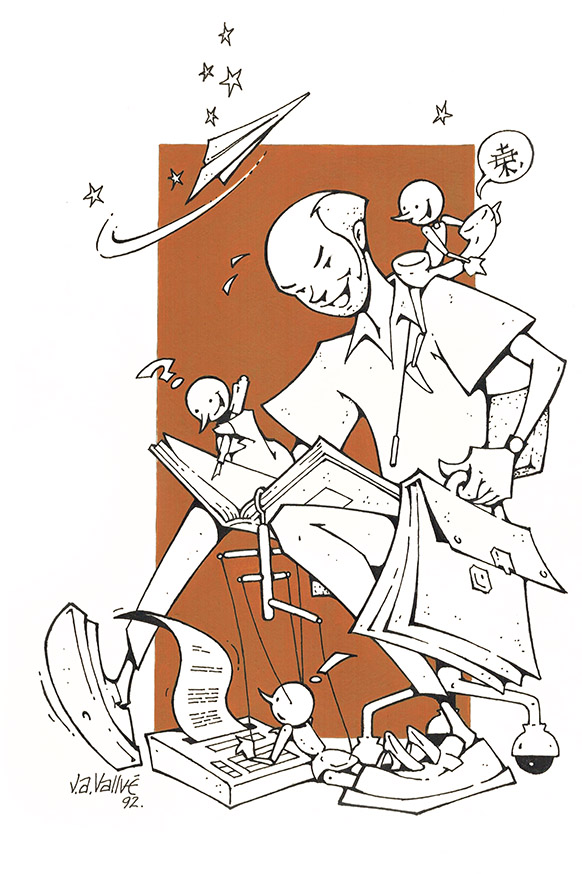PUPPETS’ METAMORPHOSES (4): In the light of shadows and cameras

Light sources, screens, shadows, epidiascopes, projectors, cameras – all of these elements of inanimate matter tend to be used in puppet theatre. Of course, they are not only used in puppetry art, but it is our main focus in this blog.
Kaunas State Puppet Theatre (Lithuania) performed at the 5th edition of Puppet’s Metamorphoses with the play „Disappearing little people” by Milda Mičiulytė, Agnė Sunklodaitė, Giedrė Brazytė, inspired by the works of Elizabeth Mary Cummings, the Australian writer of children’s literature. I am not convinced if a delicate and hushed conversation about passing, transience, losing loved ones – probably compelling and touching in the pages of Cummings’s novel – is a good concept for a shadow puppet theatre play, unfolding without words, quite static, maybe even a bit boring? These motifs should evoke strong emotions, meanwhile, I watched the performance frigidly, with great difficulty to keep up (or not at all) with the changing images, the stories of various families living in the apartment building. Not only do I not feel touched by the mini-stories, but I also look at them with indifference. So what if the large screen that almost fills the stage offers aesthetically pleasing figures, and the blending of the shadows of the live actors with silhouettes of the characters, and experimenting with proportions, and even slightly introducing colour to the dark shadows, if in the end it is completely saturated with illustrativeness and is devoid of any emotion.

What attracts the attention is mainly the technique of the shadow play, poorly known in Poland, yet extremely captivating in contemporary puppetry, like the famous Italian Teatro Gioco Vita, which has been hosting plays many times, even in Poland. Just, in this case, the use of the theatre’s resources turned out to be quite poor. The first scene with a mock-up of buildings in the background, among which animators move around holding individual light sources that allow for many shadow effects to appear on the screen, promises so much more. Then, we move to the screen, where the creators mainly use the epidiascope and this thirty-minute spectacle seems to have no end. What a shame. It is likely a new and important experience for the Kaunas team, one that requires extraordinary precision and diligence, but the effects have yet to be seen (unless – which is highly probable in an institutional theatre – this experience turns out to be a one-off meeting with the shadow play).
Such consistency in taming theatrical resources is essential to achieve above-average results. Yesterday’s performance by the Dutch TAMTAM objektentheater, run for more than 40 years by Gérard Schiphorst and Marije van der Sande, proved this. They are professional visual artists that have been working for years on object theatre, still exploring the technique popularised in the ‘90s of simultaneously creating the images live and in real time, while the final result of all animation activities is projected on a screen, visible for the live audience, set up next to the real animation workshop of the creators building the performance.

This time, TAMTAM Objektentheater presented the performance “Memories of the future, Fake news for Mars”, a quite pessimistic story about people living on Mars for many years (the action takes place in 2250) and their expedition to Earth to show the beauty the planet was once known for in the past. This past has irretrievably changed, and the Earth, a dry and almost desolate place, has nothing fascinating anymore, which makes the members of the expedition send fake news to the base, montages of old found objects discovered on earth, images from postcards found among the rubble. It creates such an untrue image of reality, one that we may be familiarised with too well by the modern media.
The performance was created during the pandemic, hence the sadness, gloominess and the lack of hope we all experienced a few years ago. That’s probably a little too predictable in the performance, performed without words. But the technical side of the performance, seen live, is truly awesome. Especially since everything is the work of just two artists. A film animation studio set up on stage, combining several different sets, multiple filming and animation techniques, and various means of artistic expression (shots with moving horizons, almost cinematic clips, direct animation, brilliant use of archaeological techniques, a really surprising creative imagination) is truly fascinating.

And this performance is not so much created by actors/ puppeteers/ performers, but it is created by sensitive artists, who once chose the theatrical techniques they want to use and constantly discover the infinite possibilities of them. What a pleasure it is to see the scenes where the members of the expedition examine the found terrestrial remains, using an object similar to a probe: the contact of the „sensor” with the remains evokes something that resembles the object’s memory, sound, voice, one might say – an image. Yes, because objects and materials, in today’s theatre of animated matter, really come alive in the contemporary puppetry and only greatly skilled artists are capable of evoking their “consciousness”, the consciousness of the puppet. Here is where the magic of theatre begins. Artists at times manage to connect with it, but even the best artists achieve it only sometimes.
Photos: B. Gudalewski


